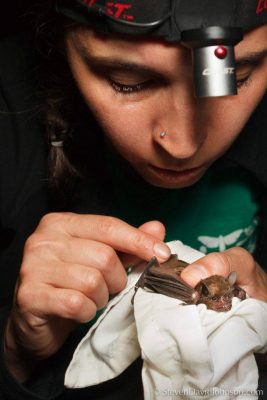Steven J. Presley, Laura M. Cisneros, Christopher L. Higgins, Brian T. Klingbeil, Samuel M. Scheiner, and Michael R. Willig
Article by: Veronica DeFelice

If you look out an airplane window, you may notice the intricate patchwork of forest, cropland, pasture, and urban areas below. Indeed, over 75% of the world has been modified for human land use with small forest patches embedded within these human-dominated landscapes. Researchers are now trying to understand the role that human-modified landscapes play in biodiversity conservation.
Drs. Steven Presley, Laura Cisneros (of NRE) and co-authors used an innovative biodiversity approach to study how human land use and forest loss impacts biodiversity of leaf-nosed bats—a diverse group that plays important roles in the ecosystem, such as pollination, seed dispersal and insect regulation—in the tropics. Their multidimensional biodiversity approach incorporates the roles that species play in the ecosystem and allows them to assess the degree to which landscape change filters species with unique roles.
To carry out this study, Dr. Cisneros traveled to the Caribbean lowlands of Costa Rica; a region where both ecotourism and agriculture are important to the economy. The complex tropical landscape comprised large forest reserves and medium to small forest fragments surrounded by banana or pineapple plantations or pasture. Cisneros and her team studied bat communities in forest patches of different sizes, surrounded by different land use. “Each afternoon, we would head out to these isolated, rural sites and hike out carrying bundles of poles and multiple large hiking backpacks of equipment to set up mist-nets used to capture bats flying through the forest patch and camp for the night” says Cisneros.
Back in Connecticut, Presley and co-authors found that the human-modified landscape caused bat communities to be more ecologically and evolutionary similar than expected by chance (referred to in the study as functional and phylogenetic underdispersion), but this impact varied with season. “In the wet season when food resources are plentiful, areas in the landscape with moderate to high forest conversion “filtered” the type of species that could persist in those areas, with primarily species that eat fruit or nectar thriving in these disturbed areas,” says Cisneros. “But in the dry season, those heterogeneous sites with moderate forest conversion supported highly diverse communities that had a number of redundant species that fulfilled similar ecological roles,” says Cisneros. “This suggests that for bats, heterogeneous landscapes with intermediate amounts of forest and agriculture can support diverse communities by providing additional resources.”